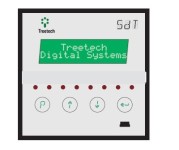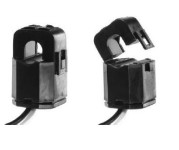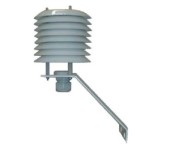SDT – Smart Device Expert Oil and Winding Temperatures Monitor
Electronic thermal monitoring for equipment such as transformers, motors, generators and other applications is essential for the safe operation of these systems. This facilitates maximum return on the investment from these assets without jeopardizing their service life. The Smart Device SDT by Treetech is a complete solution for monitoring temperatures of oil and winding temperature as well as OLTC control for oil-immersed transformers and reactors. Optionally, it also provides smartregulation of the voltage, with parameters configured by the user, thus providingimproved power quality with lower losses.
Physical Characteristics
- This IED (Intelligent Electronic Device) has been specifically designed for substation outdoor conditions (interference, extreme temperatures);
- Rugged construction, exceeding EMC standards, so as to operate flawlessly in severe electromagnetic conditions in substations and operating temperatures of -40 to 85oC;
- Total absence of mechanical parts that need configuration or calibration;
- Compact size, saving space and reducing panel costs;
- High intensity VFD (Vacuum Fluorescent Display), readable under any lighting and temperature conditions;
- Internal clock that runs 48 hours without power supply, without internal batteries;
- Non-volatile mass memory 1 GB, expandable up to 32 Gb. Maintenance free internal clock without batteries.
- Universal power supply of 85~265 Vac or Vdc, 50/60Hz.
The Smart Device SDT is supplied in two configurations, to monitor and control respective values.
Temperature Specialist Monitor – SDT (Version 1)
The SDT is a modular system that performs vital functions to monitor all temperatures with complementary functional redundancy.
Functionality
- Solution for applications with mineral, vegetable, synthetic oils and others;
- OLTC status monitoring for thermal failure detection;
- Calculation of the predicted final gradient of oil to winding temperature for the current load
- Four inputs for Pt100 temperature sensors, for ambient temperatures, transformer or OLTC oil or other;
- Oil temperature redundant measurement, avoiding unavailability of the measurement in case of Pt100 sensor failure.
- Specialist functions for preservation of cooling system service life, such as fan exercise and automatic interchange of groups;
- Optional pre-cooling function to increase the service life of the transformer insulation;
- Safe operation (switch on) of up to four forced cooling groups in the unlikely event of failure of the SDT;
- Redundant and self-calibration of temperature measurements, providing continuous operation even under stress conditions;
- Multiple safety levels for alarm operation and transformer tripping, to guarantee safe operation;
- Self-Diagnostics for the detection of internal failures or sensor and wiring problems.
- On-board Web pages for remote viewing of online measurements and graph history;
- Password-controlled configuration of the equipment;
- Measurements and alarm history on an on-board SQL database, allowing storage and access to data in a safe and efficient way withfull integration to remote online monitoring systems;
Inputs
- Four true-rms inputs to measure AC currents from the external clip-on CT’s, split core window type;
- Four inputs for self-calibrating temperature measurement from RTD PT100Ω sensors, guaranteeing high accuracy and stability throughout the temperature range;
Outputs
- 13 signal relays with programmable functionality and type (NO/NC) for alarm and self- diagnostic indication;
- Tripping contacts with settable timing from 0 to 20 minutes and countdown indication both on the display and via serial communication ports.
- Output contact to show the countdown for an ongoing trip.
- NC output contacts to operate four forced cooling groups: safe cooling actuation in event of power failure, sensor or wiring failure or internal failure, initiated by the self-diagnostic function
- NC Output contact, to indicate lack of power supply, sensor or wiring failure or internal failure detected by the self-diagnostics.
- Three analog current loop outputs for remote temperature indications, 0-1, 0-5, 0-10, 0-20 or 4-20mA ranges;
Communication
- Two RS-485 serial communication ports and one programmable RS-232/RS-485 port. IRIG_B clock synchronisation;
- Wireless communication Wi-Fi or GPRS cellular modem standards;
- Two Ethernet ports, fibre optics or RJ-45; serial F.O. option;
- USB port for laptop connection or download data from/to flash drives;
- Open protocols: Serial, IEC 61850, DNP-3.0 and Modbus RTU or on TCP/IP, FTP for remote access to files and databases and SMTP to send alarm emails;
Specialist Temperature Monitor – SDT (Versions 2 and 3)
Two complementary solutions for transformer temperature monitoring and control as well as voltage regulation. Selection of SDT versions 2 or 3 will provide both temperature monitor and control as well as voltage regulation functions, covering both requirements.
Functionality
This solution has functionality that is similar to version 1, with the addition of functionalityfor voltage regulation:
- OLTC monitoring for temperature differential detection;
- Calculation of the predicted final gradient of oil to winding temperature for the current load
- Oil temperature redundant measurement, preventing the loss of measurement in the event of Pt100 sensor failure.
- Specialist functions for preservation of cooling system service life, such as fan exercise and automatic interchange of groups;
- Optional pre-cooling function to increase the service life of the transformer insulation;
- Multiple safety levels for alarm operation and transformer tripping, to guarantee safe operation;
- Redundant and self-calibration of temperature measurements, providing continuous operation even under stress conditions;
- Two inputs for Pt100 temperature sensors, for ambient temperature, transformer oil or OLTC oil;
- Safe immediate operation of up to two forced cooling groups in the event of IED failure;
- Self-Diagnostics for the detection of internal IED failures or sensor and wiring problems.
- On-board Web pages for remote viewing of online measurements and graph history;
- Password-controlled configuration of the equipment;
- Measurements and alarm history on an on-board SQL database, allowing storage and access to data in a safe and efficient way with full integration to remote online monitoring systems;
In terms of voltage regulation, this version provides:
- Master-Slave or Circulating Current methods to provide parallel control of up to three transformers;
- Line drop Compensation using Resistance or Reactance (Rx) adjustments or through the simplified voltage drop percentage method (compensation 2)
- Local/Remote and Manual/Automatic OLTC control.
- OLTC blocking in the event of overcurrent and undervoltage. Option to select initiation if overvoltage occurs of blocking the OLTC or quick voltage reduction.
- VT/CT phase shift adjustable from 0 to 330o, allowing all variations of possible VT/CT connections;
Inputs
For the added voltageregulation functions some sensors that are used in the SDT version 1 are replaced:
- One input for transformer line voltage measurement;
- Three inputs to measure true-rms AC current, external CT clip-on split core window type;
- Two inputs to measure temperature using RTD’s, PT100Ω with self-calibration;
- Two dry contact inputs for remote commands, such as regulation program change, paralleling control and other;
- One input for resistance position transmitter, which provides OLTC tap position measuring;
Outputs
- 14 signal relays with programmable functions and type(NO/NC) for alarm and self- diagnostic indications;
- Tripping contacts with adjustable timing from 0 to 20 minutes and countdown indication both on the display and via serial communication ports.
- Output contact to show the countdown for an ongoing trip.
- NC output contacts to operate four forced cooling groups: safe cooling actuation in event of power failure, sensor or wiring failure or internal failure, initiated by the self-diagnostic function
- NC Output contact, to indicate lack of power supply, sensor or wiring failure or internal failure detected by the self-diagnostics.
- Four analog current loop outputs for remote temperature indication in the 0-1, 0-5, 0-10, 0-20 or 4-20mA ranges;
Communication
- One RS-485 serial communication port and one programmable RS-232/RS-485 port for integration to supervisory or remote monitoring systems.
- Communication linkfor parallel control of up to three transformers through third RS-485 port;
- Two Ethernet ports, fibre optics or RJ-45, with serial F.O. option;
- USB port for laptop connection or download data from/to flash drives;
- Wireless communication, Wi-Fi or GPRS cellular modem standards;
- Open protocols: IEC 61850, Modbus RTU or DNP 3.0, with time-stamp support for events such as alarms, trips, cooling on, etc., with 1ms resolution;
Accessories
- External Split Core Clip-On CTs
- Auxiliary Voltage Transformers
- PT100Ω temperature sensors at 0ºC
- Ambient Temperature Sensor:
The SDTs temperature inputs may be used to measure CDC, motors, generators, ambient temperature, etc. If used to measureambient temperature, the PT100 sensor should be installed in a weather shield.



